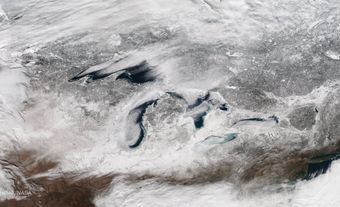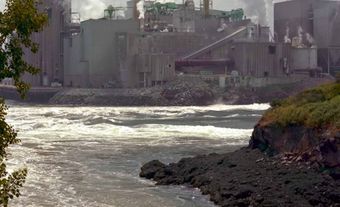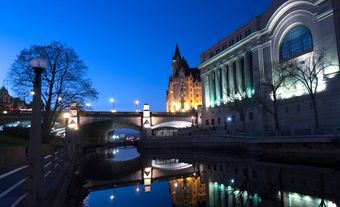Canada is unique in having almost 800 000 km2 of freshwater within its boundaries. The lakes which make up most of this vast area are interconnected by river systems. The Mackenzie River, draining an area of 1 870 000 km2, is the seventh-largest river system of the world. Better known is the St Lawrence River-Great Lakes Waterway, extending halfway across the continent. Using Canada's inland waterways, it is possible to travel on water, by canoe, from tide water near Québec to the Arctic coast in the far northwest, and even across the mountains to the Pacific coast.
These 2 great journeys were first made just before the end of the 18th century, and by the same man. Alexander Mackenzie reached the mouth of the river which now bears his name in 1789, and was the first European to cross the North American continent (to Bella Coola) in 1793. He was one of the almost legendary fur trader-explorers of those days. Banded together in the North West Company, these men, with native and Métis guides and translators, pioneered the exploration of the main water routes of the West and the mid-West.
One of the barriers they had to pass was the rough water of the St Marys River as it leaves Lake Superior. Here the NWC constructed one of the first navigation locks in Canada (1819), a small affair indeed, as were the even earlier tiny locks at rapids in the Soulanges section of the St Lawrence, started by the Royal Engineers (1779) under the direction of Governor Haldimand. With a depth over sills of less than 0.5 m, these primitive locks were the beginnings of Canada's notable group of canals, some still in use in their original form, others enlarged and improved (see Fur Trade Routes).
The Lachine Canal, built between 1821 and 1825, and bypassing the rapids on the St Lawrence upstream from Montréal, was the first real canal to be finished. Planned by Montréal merchants, it required substantial investment of public funds before completion. The other canals of this early period, the 3 Ottawa River canals (1819-34) and the Rideau Canal (1826-32), were planned and built to provide an alternative military waterway between Montréal and Kingston following the War of 1812. They were therefore paid for by government, even though they were used for commerce rather than military traffic.
The Ottawa River canals were in use until 1961 when they were submerged by the Carillon hydroelectric dam of Hydro-Québec. Navigation remains possible via a new lock adjacent to the Carillon powerhouse. The Rideau Canal is still in regular use, essentially as built over 150 years ago. Rapids on the Richelieu River, upstream from St-Jean, Québec, were bypassed by the Chambly Canal (1833-43). With a lock at St-Ours, near Sorel, vessels had access from the St Lawrence to Lake Champlain and so to the Champlain Canal (US) and the Hudson River. But the narrow locks on the Chambly Canal (only 7.1 m wide) were, and still are, a bottleneck in this international waterway.
Great plans for canals were developed in the Maritime provinces. The Shubenacadie Canal, linking Halifax with the Bay of Fundy, was started in 1826 but completed only in 1861, being lightly used for a mere 10 years. The little St Peter's Canal, linking Bras d'Or Lake with the ocean, was built between 1854 and 1869; enlarged, it is still in use. The greatest dream of all, from as early as 1686, was for a canal across the Isthmus of Chignecto. Studied more than any other canal project in Canada, it has not yet been built, although a massive marine railway, as an alternative, was started in 1882, only to be abandoned in 1891 before completion.
All of these early canals, as well as the Trent Canal system, which follows old Indian routes through the Kawartha Lakes, were intended to facilitate the movement of small steamboats. The Chambly Canal and the Grenville Canal (one of the Ottawa River canals) were alone in their resemblance to the familiar canals of Europe with towpaths for horse-haulage of barges.
In the second half of the 19th century, as the population of Canada became more mobile, and in the absence of improved roads, steamboat services proliferated on all the country's major rivers and lakes. For many years, Sir John A. Macdonald had a cabin reserved on the fine daily boat service between Ottawa and Montréal. Some of the services lasted well into the 20th century. The Montréal-Québec-Saguenay service, for example, stopped in 1965; that on the Mackenzie River still operates, although now with diesel-powered vessels.
The greatest success in the improvement of Canada's waterways has been the development of the St Lawrence River into the St. Lawrence Seaway of today. The Lachine Canal (1825) was the real start, closely followed by the completion in 1829 of the first Welland Canal. Forty small timber locks were required to raise vessels the 100 m from Lake Ontario to Lake Erie, most of them necessary for the steep climb up the Niagara escarpment. Initially built with private funds, the Welland Canal was later taken over by government (as was the Lachine Canal).
In effect, all improvements to the waterways of Canada have been publicly financed, and the facilities operated by government. The Welland Canal was rebuilt (1845) with larger locks, now of masonry, as one of the first major operations of the new Board of Works of the United Province of Canada. The Board also completed the several small canals necessary for overcoming the rapids on the St Lawrence between Lake St Louis and Lake Ontario - the Beauharnois (later Soulanges), Cornwall and Williamsburg canals. Only at mid-century was this group of canals complete and in regular use. From 1834 to 1850 the Ottawa River canals and the Rideau Canal, with the rivers they served, constituted the Seaway.
Following Confederation in 1867, inland transportation in Canada was given high priority by the new government. The 1870s and 1880s were years of active canal rebuilding and improvement. The bottleneck locks on the Grenville, the third of the Ottawa River canals, were finally rebuilt; a new Carillon Canal replaced the original canal and the Chute à Blondeau single-lock canal. All the locks on the Lachine and St Lawrence River canals were rebuilt in this period to standard dimensions, each 84 m long and 14 m wide with a depth over sills of 4.2 m (14 feet). The third Welland Canal, a major rebuilding of the second, was finished by 1887. To serve the new St Lawrence system, a fleet of almost 200 stubby, inelegant but efficient freight steamers was gradually developed, achieving fame as "the fourteen-footers" and serving faithfully for 75 years.
After 1909, control of the St Lawrence River came under the International Joint Commission, a Canadian-US tribunal. Discussion of a much enlarged canal system intensified almost immediately. The Ottawa River provided a 483-km shorter route for a seaway to the Great Lakes, but the general election of 1911 put an end to the dream of the Georgian Bay Ship Canal.
Construction of the fourth Welland Canal, as part of the alternative St Lawrence route, started in 1913. A wholly Canadian venture, this world-famous canal, with only 8 locks, was officially opened in 1932. Its locks, 260 m long by 24 m wide, enabled a fleet of "upper lakers" to be developed for bulk freight service; they later dictated the size of the St Lawrence Seaway locks when the Seaway was built (1954-59) (see Lake Carriers).
Today, the St Lawrence Seaway, incorporating the fourth Welland Canal, is one of the few great ship canals of the world, carrying freight from and to the rest of the world and to and from the heart of the North American continent. The great passenger ship services of earlier years have almost all disappeared, their place now taken (especially on the smaller canals) by ubiquitous private pleasure craft. Once away from these main routes, the lakes and streams remain as one of the delights of Canada. Still used today as they have been for centuries, they illustrate how appropriate the designation "Dominion" is for Canada - "from sea to sea, and from the river unto the ends of the Earth."

 Share on Facebook
Share on Facebook Share on X
Share on X Share by Email
Share by Email Share on Google Classroom
Share on Google Classroom






